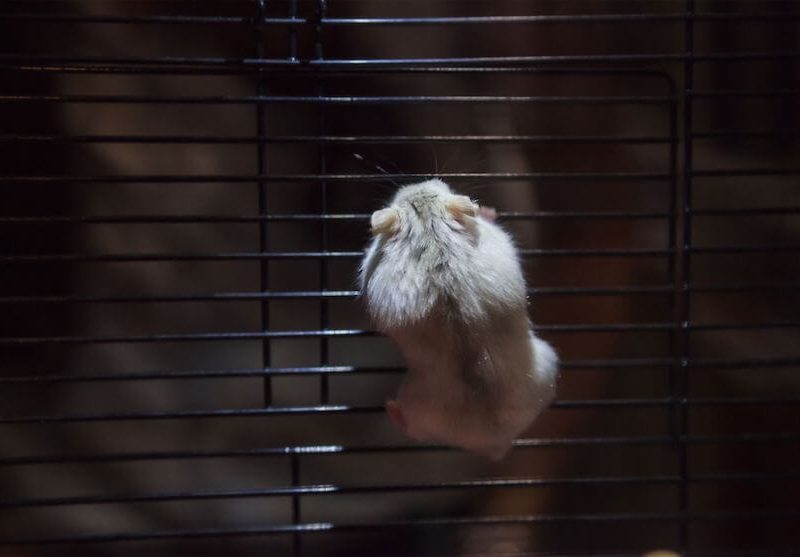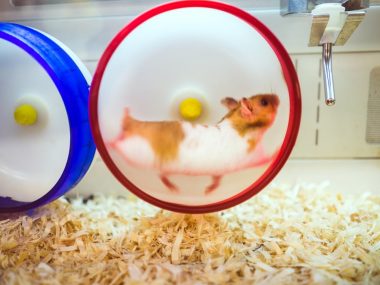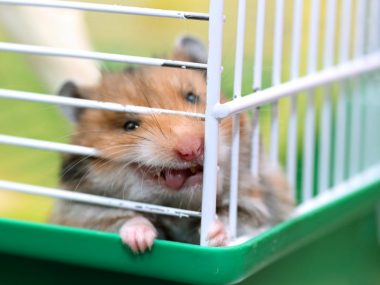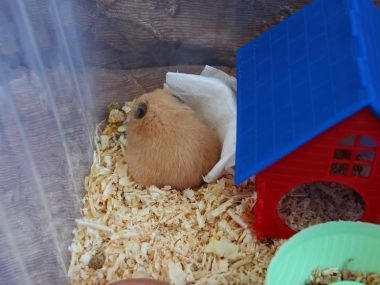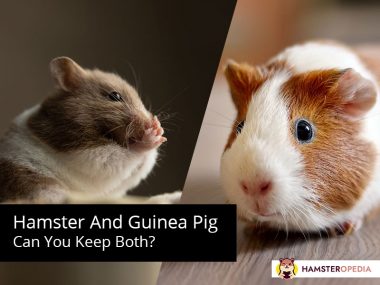“Fluffy’s” little beady eyes are hiding a secret that we can bet you didn’t know about. If a pair of eyeglasses could fit a hamster, it would solve the problem! But can hamsters otherwise see in the dark?
Table of Contents
Can Hamsters See Well At Night?
Hamsters are nocturnal animals. They sleep during the day and become active at night. One would think that because they are nocturnal, they would have vision designed for seeing at night. However, hamster eyes may not be as astutely in tune with darkness as assumed. In fact, they do not see well at night.
An article published by Trends in Neurosciences (“What can mice tell us about how vision works?”) details a study done on vision in nocturnal rodents. Interestingly, it mentions rodents (such as hamsters) lack high resolution in vision with a 20/2000 vision rating (extreme nearsightedness). Their vision is designed for seeing in low-light conditions by having rod-dominant/dependent retinas.
Human beings see images by photoreceptors absorbing light which causes a chemical reaction that tells our brains what the image is. This occurs through cones on our retina and macula. Our retinas are cone-dominant. Cones are responsible for high-resolution vision.
The DVM360 (MJH Life Sciences) states that nocturnal animals (such as cats, hamsters, mice, bats, owls, etc.) have rod-dominant retinas and fewer cones. When one of these animals sees an image, the photoreceptor on the rods in the retina absorbs what little light there is, causing a chemical reaction that tells their brain what the image is.
By having more rods than cones, these animals can detect images in low light conditions. This is known as night vision. The downside to not having more rods than cones is poor eyesight and high sensitivity to light. By having few cones, it’s difficult to detect movement quickly and to distinguish colors (color blind). Colorblind animals such as hamsters see things in various shades of gray just as cats and other similar night prowling animals.
If you were to ask, “How do hamsters see,” we would tell you they have poor vision, are color blind, and do better in low-light environments. To them, that hot pink hamster wheel you splurged and got them is gray.
Hamster Adaptation To Light Conditions
In the wild, hamsters burrow at depths up to 10 feet underground. They stay in the dark burrows during the day to sleep and to avoid the harsh light of day. They have managed to adapt to environmental light by developing a circadian rhythm known as nocturnal.
Pet hamsters instinctually continue to follow this sleep regime by getting into their nesting box or burrow down into the bedding to hide from the daylight. When exposed to intense light like the sun, a bright lamp, or overhead light, they tend to freeze as if they have been stunned. This is why placing a lamp near their cage is not recommended or putting their cage in front of a window.
As pups, the exposure to harsh light actually hurts their eyes, and in the wild, they don’t come out of the protection of their dark burrows until they are more grown.
Hamsters are Seeing With Whiskers

Those cute little wire-like whiskers on your hamster play a significant role in helping them see in the dark. Not only do hamsters use whiskers to sense objects around them, but many other animals do as well (cats, dogs, possums, and more.)
“Sensing The Environment With Whiskers” is a published article in which researchers studied how animal whiskers aid in seeing the unseen in the dark. A hamster is a prime example of this unique asset. Down in the utterly dark burrows that wild hamsters live in, it’s their whiskers that guide them through the tunnels.
Whiskers got their name from the whisking motion animals use to detect nearby objects. Hamsters move their whiskers in a modulated motion to determine the presence of objects or their position in relation to those objects.
If you’ve ever gotten up in the middle of the night and turned the light on to find a mouse scurrying along the wall, there’s a reason it hugs the wall rather than running out in the open area. When the lights are off, and it’s pitch dark, they cannot see well at all. Instead, they rely on their whiskers to run along the baseboards to guide them.
So at least now you have an idea how whiskers in rodents (and your hamster) acts as a second set of eyes in the dark.
Can Hamsters See In Total Darkness?
Although hamsters have night vision, they cannot see in utter darkness. When foraging in the wild at night, having the light of the moon helps them to see. However, should a night be black as tar, they will have trouble seeing. The same principle applies to the room you have their cage in. Hamster eyesight is at its best during dusk and dawn.
So Is It Okay For Hamsters To Be In The Dark?
It’s natural for a hamster to be in the dark come nighttime. Some hamster parents are inclined to put a dimly lit lamp in the room where their hamster’s cage is at night. However, before you plug in that night light or lamp for your hamster after the sun goes down, think twice.
A research article (“Dim light at night disrupts the short-day response in Siberian hamsters“) revealed the results of a study on how lights affect the circadian rhythm of Siberian hamsters. It mentions that artificial light potentially disrupts a hamster’s body clock. A hamster fails to produce melatonin when any amount of light is present.
So, in answer to whether a hamster should be in the dark at night or at night, the evidence indicates dark is okay and ideal for a hamster’s well-being.
A “Green Light” On Darkness
Learning more about a hamster’s vision and whether or not a hamster can see in the dark helps us to better understand our beloved pet. Come nighttime, dark is best. Pass on the nightlight and lamp because it’s perfectly natural for your hammie to be in the dark once the sun goes down.
